Questioning Game Design
 Here at SebSpot we decided to take a moment to shine a light on some design choices in games that just didn’t jive with us. The following is a list of elements that left us frustrated, disappointed, annoyed, or even just confused. We welcome any input or rebuttals that you have to offer, but just remember that we still loved a lot of these games. In some cases it’s the sheer amount of time that we spent with these titles that brought the questions to the surface.
Here at SebSpot we decided to take a moment to shine a light on some design choices in games that just didn’t jive with us. The following is a list of elements that left us frustrated, disappointed, annoyed, or even just confused. We welcome any input or rebuttals that you have to offer, but just remember that we still loved a lot of these games. In some cases it’s the sheer amount of time that we spent with these titles that brought the questions to the surface.
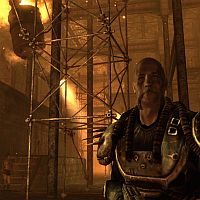 Fallout 3
Fallout 3
Removing the Dillema from Moral Decisions. This happens in a lot of games, but Extra Credits reminded me of a perfect example in Fallout 3. In the DLC entitled The Pitt you arrive at a scenario where you must decide to either kidnap an innocent girl to aid the prisoners or to kill them all in order to defend her. Neither decision is inherently good or bad. If you help the girl you have to kill an entire community of people. If you help the people who are trapped in the Pitt you have to steal and endanger a perfectly innocent child that has done nothing to cause or deserve to be in this situation. If this was all that there was to the situation it would be an impressive dilemma, but once you make your choice you’re rewarded with either positive or negative karma based on which decision the developer arbitrarily decided was good or bad. In essence the developer is telling you that there’s a correct answer to a question that should be left wide open.
Many games also have certain perks or abilities that are only available to players who are purely good or entirely evil. Not only does this remove the chance for a dilemma, but it also removes choice altogether. Any player who is aware of these unlockables is going to play through the entire game as either a saint or a demon, grinding their way toward that special spell in the same way they would with an experience bar. All of the complexity that is required to create a meaningful experience is banished and replaced by a stat ticker.
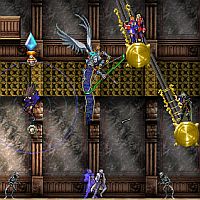 Castlevania: Harmony of Despair
Castlevania: Harmony of Despair
No Local Multiplayer. When Castlevania: Harmony of Despair came out, I was definitely excited to jump with in and give it a try. So I went online and had an absolute blast playing through it. The game is perfectly oriented toward multiplayer, after all; the levels aren’t particularly long or anything, but you really have to work together to get through it and there’s a nice sense of accomplishment once you do. So, the next day I talk up the game to my brother and he agrees to play and…wait? What? No local multiplayer? This is when you realize the game is too oriented around MP; playing single player, especially early on, is practically impossible. Why make this decision? I can certainly understand capping local multiplayer at four due to that being the maximum number of controller inputs on the 360, but none at all is simply baffling.
 Mafia II
Mafia II
“Why is this wanted poster on the roof?!” We’ve all played our fair share of sandbox titles by now. You have a series of missions on your map that can be undertaken in order to progress a branched story, but you can also pour hours into the side missions and a series of silly minigames. Mafia II has none of that. You play an entirely linear, story-driven campaign that offers no additional content or reasons to deviate from the path. That’s completely okay by me. I really enjoyed the story in Mafia II and think that making it linear was the right call, but why does the sandbox mechanic exist? It seems to only be there as an excuse to jam collectibles into the game or so that the level designers can show off all of their hard work. Waking up in my own bed, driving to work, and then driving back after each mission did nothing to enhance the experience. L.A. Noire made the smarter call of having each case start out with you already at the station, and it ends each mission the moment the case has been solved.
 Guitar Hero: Warriors of Rock
Guitar Hero: Warriors of Rock
Flashy but Pointless. GH: WoR introduced introduced a new gameplay element where you would pick up a variety of powers throughout the game’s career. The problem was that all you can do in Guitar Hero is play the notes on the screen and activate Star Power, so all of these abilities had to be passive. This meant that you could get more star power, protect your streaks, avoid failing, and enjoy several other passive effects. Because they were all passive, though, they actually did nothing to impact the gameplay because you were still doing the exact same thing. Aside from some flashy effects on the screen the only real impact they had on players was to make it impossible to get any meaningful scores during their playthrough and to force achievement hunters to play through the entire campaign a second time.
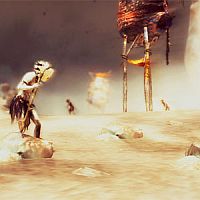 From Dust
From Dust
“Listen to the giant ball of sand, dammit!” From Dust was a very interesting and unique take on the god game, and I thoroughly enjoyed playing through the story. It wasn’t until I reached the challenge mode that things began to fall apart. In this game you have zero control over villagers aside from telling them where to build. You can’t even control which ones do what you want them to do. This means that when you’re in the final challenge and the entire island is sinking if you ask them to build a village on top of the mountain you might as well be asking them to fly. They’ll take the worst possible route, get blocked by an impossible-to-see damp spot, or even come from the farthest possible village that is already isolated from you goal. This can leads to hours of repeated attempts on a challenge that you already know the solution for, and it really shines a bright light on every single flaw that the game has. From Dust was a game about finding creative solutions to complicated problems, but the challenge mode felt more like a time trial mod created by a fan that failed to recognize From Dust’s limitations.
 Rock Band 3
Rock Band 3
Pro Drums Mode is like a Ninja! Rock Band 3 gave fans access to a “pro” mode that allowed them to play more realistic versions of their favorite songs. This meant guitar and bass players could perform their parts with a controller that had strings and frets, keyboardists had full access to two octaves of keys, and drummers could play the cymbals in their songs if they bought the correct drum expansion. Much to our surprise, every single drum chart ever released by Harmonix already had a pro drum chart that we had simply never had access to before. It was nothing but good news at the time, but I can’t help but wonder why we had never been allowed to play them before. After all, that’s a lot of work to put into a piece of the game that no one could play. There were already fairly useless cymbal add-ons for the drum kit out on the market, so why not use those? Stranger still is the fact that those cymbal packs only had two additional pads even though the drum charts that already existed had three. Early Rock Band Network authors were never given the ability to chart pro drums, so the first several hundred RBN tracks are actually the only ones in existence that lack this feature.
Phantom Band Mate. Rock Band 3 added a fifth instrument, the keyboard, but still only shows four characters on the stage at once. You can have a bass player or a keys player on stage, but not both. It’s truly a bizarre sight to see when you’re playing with five or seven players. Seeing various band members chime in helps the harmonies make sense, but are we meant to believe that the drummer is farting out that sick piano solo?
Tug-o’-WHAT?! Being able to access the leaderboard and filter to your friends for any song in your library is a pretty cool addition, but it seems to have come at the cost of traditional competitive modes. Remember Score Duel, that head to head battle mode that’s been in every Rock Band and Guitar Hero game so far? Gone. It really caught me by surprise because I can’t remember the last multiplayer music game I played that didn’t allow me to face off against my friend locally. The primary person that I used to play Rock Band 2 with has almost lost interest entirely because of this change alone. It’s rare to see a sequel that decides to drop a feature altogether.
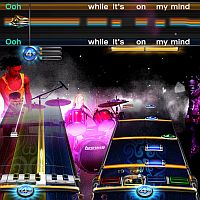 All Instrument Mode and the Online Confusion. In order to allow more than four local players Harmonix added an “All Instruments Mode,” which allows the vocalist to play without using a profile. They essentially don’t count as a player. This makes perfect sense for local play, but for some reason you’re also limited to four players when you go online. Most FPS titles allow up to 16 players and Guitar Hero managed to get up to eight, so why does Rock Band 3 have this limit? What makes the situation even more odd is that you can’t just use any combination of four instruments. A four player online band must have a drummer, a singer, and any two of the three remaining instruments. This means that you can’t have a guitar, bass, and keys player in the same session. Why? One might assume that it has to do with there only being either a bass or keys player on stage at a time, but Harmonix had no problem with allowing invisible band mates in All Instruments Mode.
All Instrument Mode and the Online Confusion. In order to allow more than four local players Harmonix added an “All Instruments Mode,” which allows the vocalist to play without using a profile. They essentially don’t count as a player. This makes perfect sense for local play, but for some reason you’re also limited to four players when you go online. Most FPS titles allow up to 16 players and Guitar Hero managed to get up to eight, so why does Rock Band 3 have this limit? What makes the situation even more odd is that you can’t just use any combination of four instruments. A four player online band must have a drummer, a singer, and any two of the three remaining instruments. This means that you can’t have a guitar, bass, and keys player in the same session. Why? One might assume that it has to do with there only being either a bass or keys player on stage at a time, but Harmonix had no problem with allowing invisible band mates in All Instruments Mode.
“Harmonies, why do you hate me?” Harmonies were introduced in Beatles Rock Band and allow up to three singers to share the vocals in a song. This leads to some pretty interesting and challenging experiences in songs like Bohemian Rhapsody by Queen, where each singer can end up playing wildly different roles in the song at the same time. You can only use this mode locally, however. A lot of this follows a similar mindset as my complaints about playing as a full band online. Console games already allow for you to get a massive number of players into a single game, so why is the multiplayer so limited in Rock Band 3? Simply allow us to get a group of seven people together in a lobby based on what instruments we are using. The three singers could choose which of the three colors they’re going to play as in a similar manner to how the guitarist and bass player choose their parts. I keep hearing the bandwidth excuse, but the singers don’t necessarily need to hear each other as long as the game can tell whether or not they end each phrase with a Triple Awesome or not. This would actually reduce confusion while singing harmonies because you wouldn’t have to deal with overlapping lines or multiple sets of lyrics.
The Great Wall of Gray. This one is more of a personal issue. I have a pretty massive collection of Rock Band DLC, and for obvious reason the cross section between my collection and that of three other people can get very small. This means that I have to scroll through hundreds of songs with dimmed titles in order to figure out what I’m allowed to play. Rock Band 3 added an impressive amount of sorting options and filters to the series, so I can’t help but wonder why none of them allow me to hide the songs that I’m unable to play during online sessions. Instead I usually just don’t bother adding songs to our setlist and allow everyone else to figure it out.
 Bioshock
Bioshock
Achievement Denied! We all know by now about the audio diaries in Bioshock. They do an excellent job of filling in the back story of Rapture, but there was also an achievement that required you to find them all. “No problem,” you might say, “the entire game lets you free-roam, anyway!” While this is certainly true for the vast majority of the game’s world, there are actually a couple collectibles hidden in the very first area of the game which you are never allowed to return to. Who doesn’t love reaching the end of a game, only to realize that you ruined your chance at an achievement during the first five minutes?
 Bulletstorm
Bulletstorm
“Did they forget what game they were working on?” Bulletstorm advertises itself as a playful run-and-gun shooter that has a heavy emphasis on killing enemies in unique and humorous ways. The multiplayer mode certainly allows for some creativity, but the campaign completely drops the ball here. Most of the linear environments only have one object in the environment that allows for interesting kills, and that lone object will simply repeat itself throughout the level until the game switches to a different lone object. Before long a game that pretends to be packed with variety actually feels monotonous and annoying. They also betrayed the classic run-and-gun vibe that they were going for by making your character fairly easy to kill. This meant that instead of storming through a level with your bad ass powers at hand you had to progress through battles slowly and with caution because sticking your head out for a few seconds too long meant that it would be ripped from your body.
 Call of Duty
Call of Duty
“What kind of shooter rewards you ’cause you got shot?” Multiple recent Call of Duty titles feature a perk that allows you to stay “alive” for a while longer after you’ve been killed so that you can shoot back at your attackers. You have a limited field of view and a generally lower chance of actually scoring a kill while this perk is active, but it’s a chance that you really shouldn’t be given in the first place. You died fair and square, so why should you be rewarded?
“Who am I and why am I doing this?” Call of Duty games have a bad tendency to switch back and forth between multiple characters in the middle of a campaign. This makes an already convoluted and nonsensical plot even more confusing, and often frustrates players that are trying to understand what’s going on rather than just mindlessly shooting their way through each stage. This was actually used well in Call of Duty 4 (the nuke!), but the positive feedback earned by that game seems to have kicked this habit into overdrive. I honestly can’t tell you how many individual characters I played as in Modern Warfare 2 and Black Ops because none of them are really defined as characters by anything but their names. Several characters only exist so that you can immediately die as them. I don’t recommend that even the biggest fans try to untangle this web of overlapping perspectives and plot lines because in the end your only reward will be the realization that it doesn’t really make sense. Or is that a spoiler?
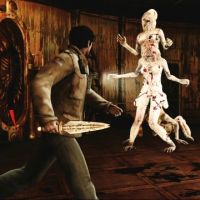 Silent Hill Homecoming
Silent Hill Homecoming
“Why doesn’t down go up?!” Yes, I know that not every game is a flight sim and I know it’s not the norm, but I’m one of those folks that inverts controls on *every* game (minus Child of Eden, for some reason). Silent Hill Homecoming was made practically unplayable for the inversion-challenged by the developer’s curious decision to not include an inversion option for the title. Inversion is so common that it’s a setting on the Xbox itself, but apparently not a big enough thing to include in Silent Hill. I guess they helt they had to make it more horrifying by causing me to look skyward while I’m attempting to strike the low-to-the-ground enemies that are presently gnawing at my knees. I enjoyed Silent Hill Homecoming, but the only other game I can think of that lacked an inversion option was Yaris. Any time you’re in such dubious company, you know there’s trouble.
 World of Warcraft
World of Warcraft
You WERE Prepared. Millions of people bought World of Warcraft’s first expansion, The Burning Crusade, because they wanted to try their hand at taking down Illidan, the ultimate baddie. This guy was massive, with freaky tattoos, horns, wings, and two glowing green warglaives that every warrior and rogue wanted for themselves. In a beautiful cinematic he greeted each new player with the foreboding line, “you are not prepared!” You couldn’t actually fight him at launch, but that was okay because you knew that he was going to be the big final boss of the expansion. He was planned to be in the Tier 6 dungeon, so players had to battle their way through the 4th and 5th tiers of dungeons in order to gain access. The Black Temple turned out to be one hell of a challenge, but before long many guilds had made their way though and killed the guy that was on the cover art of their expansion pack. The Sunwell dungeon was soon introduced, which many called Tier 6.5. Until that point everyone had seemed to think that Illidan was the boss of the Burning Crusade expansion, so this was unexpected. Did Blizzard get surprised by how quickly their community progressed through their game and decide to release content from the Lich King expansion early in order to buy themselves more time? I sure think so.
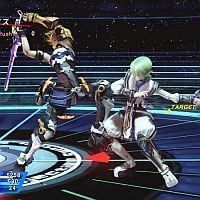 Star Ocean: The Last Hope
Star Ocean: The Last Hope
Front-Loaded Tutorial From Hell. The most recent Star Ocean game hits you right from the start with a simply massive tutorial. I had never played a game in the series before and had no concept in mind for what the combat would be like, so I made the mistake of going through all of it. After spending an hour with the various tactics and mumbo jumbo I had already forgotten most of the content that I had covered earlier in that session. Put off and still mostly confused, I ended up playing a different game entirely and didn’t touch the title for a good nine months. Much to my surprise the combat actually felt pretty simplistic. If you want a good example of why J-RPG titles haven’t been in their golden age for a while, this is a great example. This was a case where the unintuitive, convoluted design of a game actually prevented me from starting the story!
– – – – –
I hope that you’ve enjoyed our ranting. If we have enough ideas in the future we just might do this again.
Contributions:
(Castlevania: Harmony of Despair, Silent Hill Homecoming)


February 1, 2012 at 11:55 pm
Hey Sebastian and company! I totally agree with you on Bioshock, it was either that game, or a game like it, that single-handedly changed my gaming habits forever. Because of “missable” achievements, I NEVER start a game without going through the achievement lists to make sure that I won’t miss out on one little thing and get “screwed”. I find this to be a shame, since I usually like to pop a game in and go through it just to enjoy the story before “worrying” about any achievements. My makeshift solution is to avoid reading anything story-related, but I just wish I didn’t have that “cloud” hanging over me before I start any game. I have no problem going through a game multiple times if necessary [doing this with Fable 2 currently], but feeling like I need to “research” every game before I play it to make sure I’m not “forced” to replay something I don’t want to is such an unfortunate issue I find myself facing 😛
As for “From Dust”, I’m curious what your issue was… Was it that the game had limitations at all? Or was it that you clearly didn’t figure out the proper way to beat the final puzzle of “challenge mode”? As well, I do have an interesting story about that level if anyone is curious to hear it.
February 7, 2012 at 9:26 am
My issue with From Dust (which made my top 10 games of 2011, by the way) was that the mechanics and controls were clearly designed around the free form campaign with an emphasis on playful experimentation. Once they were applied to a heavily time-sensitive challenge mode everything began to fall apart and the mechanics felt sloppy. The design of the game and the concept of the mode just didn’t mix well and it made an experience that had been near flawless suddenly not fun. You can’t just throw in a challenge mode into any random game without consideration for how the controls and overall gameplay would hold up. It’s kind of like throwing a horde mode into Viva Pinata.